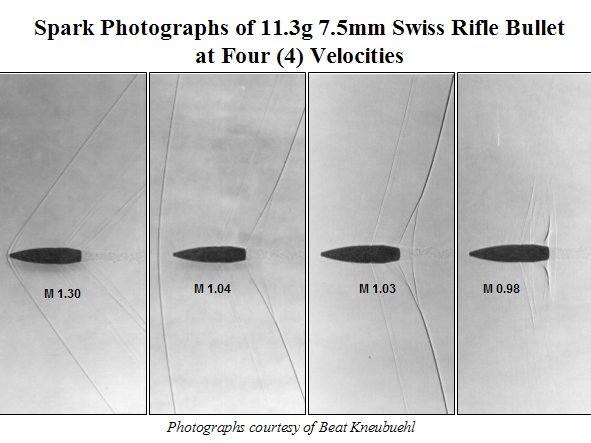When a bullet goes subsonic
#11
Guest
Posts: n/a
Ballisticians have known for hundreds of years the need to stabilize projectiles for best trajectory, without any knowledge of a sound barrier. A .22 cal. 35 grain rimfire standard velocity is stable at its designed velocities and ranges. A .22 cal. 55 grain boat tail round from a 22.250 needs totally different velocities, rate of twists, barrel lengths, powder type for burn rates etc. to perform at its anticipated ranges and velocities. All bullets eventuallly destabilize and fall to earth, it is just a matter of how soon. The
#12
The way I understand it...
When a supersonic bullets enters the transonic velocity the pressure instantly and violently shifts from the rear of the bullet to the nose of the bullet. If you look at a back lit photo of super and sub sonic bullets you will see the shock wave shift forward of the bullets nose when it goes subsonic. I believe when this happens it is almost like the bullet hit a solid barrier and thus tumbles.
In the pic below you can see the shock wave shift forward of the bullets nose and instantly the bullets is pushing against real air instead of the shock wave.
Another thing that happens is ultra low drag created during super sonic flight disappears and the bullet instantly feels greater drag which i believe adds to destabilizing the bullet.

When a supersonic bullets enters the transonic velocity the pressure instantly and violently shifts from the rear of the bullet to the nose of the bullet. If you look at a back lit photo of super and sub sonic bullets you will see the shock wave shift forward of the bullets nose when it goes subsonic. I believe when this happens it is almost like the bullet hit a solid barrier and thus tumbles.
In the pic below you can see the shock wave shift forward of the bullets nose and instantly the bullets is pushing against real air instead of the shock wave.
Another thing that happens is ultra low drag created during super sonic flight disappears and the bullet instantly feels greater drag which i believe adds to destabilizing the bullet.

#14
Nontypical Buck
Join Date: Aug 2004
Location: Michigan
Posts: 3,329
Wow what a great post. Learned something today.
So question. Speed of sound is around 760 mph. Converted to fps that would yield approx. 1,114 fps.
So can we say that the max accuracy range of a projectile is when it's speed drops below 1,110fps roughly?
Tom
So question. Speed of sound is around 760 mph. Converted to fps that would yield approx. 1,114 fps.
So can we say that the max accuracy range of a projectile is when it's speed drops below 1,110fps roughly?
Tom
#15
Statjunk....transsonic velocity range goes up to around 1.20 Mach where problems start, so from my understanding it would be a bit faster than you've listed. Of course, there are a variety of things to be accounted for when overcoming transsonic trouble. I've scarcely room to talk about anything more than 'basic' here....
#16
Guest
Posts: n/a
Well thats the big contraversy. I would say its when any part of the bullet causes supersonic wave. So as BB showed, it be lower than that transonic. But a good rough rule of thumb is at least 1110fps. That number changes greatly with Altitude and temp, and humidy also. Supersonic numbers go down with altitude but drag also goes down dow TOF goes down. Also the TOF goes up with lower temperature.
#17
Nontypical Buck
Join Date: Aug 2004
Location: Michigan
Posts: 3,329
What if you shot a high BC bullet subsonic. Would it not see this violent shift? Or is there yet another level?
Since we are dealing with change if you fire a bullet at a very very high rate of speed will this violent shift occur at yet a higher speed because of the extremity of the change? Or is the issue truly related to the speed of sound?
Tom
Since we are dealing with change if you fire a bullet at a very very high rate of speed will this violent shift occur at yet a higher speed because of the extremity of the change? Or is the issue truly related to the speed of sound?
Tom
#18
If the bullet is initially fired at sub sonic velocities then there would be no destabilization because there would be no shift in the pressure waves. Same would be true if a bullet were to remain super sonic. So long as it is sub sonic or super sonic there will be no shift in the pressure waves and no shift between high drag at sub sonic velocities and low drag at super sonic velocities. Only when the bullet (air plane, rocket, etc...) moves through the transonic region will this shift of pressure and drag occur.
#20
Fork Horn
Join Date: Sep 2009
Location: Tug Hill NY
Posts: 420
I dont recall if he mentioned any similar problem going back down through it.


